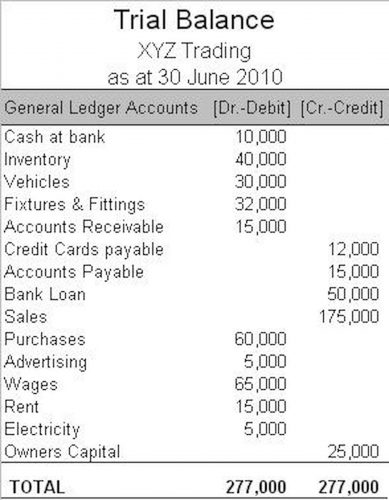Content

By doing this, the management of the company is able to measure its financial performance. Generally, cost accounting provides the management with comprehensive information that helps them to plan for the future as well as control the current operations. Note that since the managers make What Is Cost Accounting decisions only for their firms, they don’t have to compare their information to that of other firms. What they do is to ensure that the information is relevant to a particular setting. Managers majorly use cost accounting information to make decisions for the well being of the company.

Project accounting groups costs based on discrete projects, primarily in construction and professional services. Project accounting empowers good cost management and financial analysis; plus, the added benefit of being intuitive to non-accountants. There are common types of cost accounting and the results show up on financial statements.
Marginal Costing
This analysis is usually conducted for large-volume special deals. Driving lean changes from a deep understanding of the value created for the customers. Radical simplification and elimination of transactional control systems by eliminating the need for them. Amanda Jackson has expertise https://www.bookstime.com/ in personal finance, investing, and social services. She is a library professional, transcriptionist, editor, and fact-checker. Andy Smith is a Certified Financial Planner (CFP®), licensed realtor and educator with over 35 years of diverse financial management experience.
If the standard cost of the material is much lower than the actual, management knows to investigate. Such a variance can be caused by missing or even stolen materials. Consider the cost of producing one laptop versus producing two laptops. If it costs $400 to produce one laptop, but $750 to produce two then the marginal cost is $350. In other words, producing an additional laptop costs less than what it did to produce the first one. This is determined by subtracting the cost of producing two from the cost of producing one. The marginal cost thereby informs a business that by increasing production they will decrease the average cost of laptops.
Fixed Costs
As well, the business will want to know that the money being spent now is being done in ways that help maximize the company’s profit. Here’s an example of cost accounting for a typical small manufacturing company we’ll call “Bellmore Gizmos.” The company produces a variety of widgets, but they all have roughly the same costs of production. Bellmore Gizmos uses standard cost accounting, which means overhead costs are allocated across the entire production. Companies that implement cost accounting usually deal with variable and fixed costs.
Cost accounting provides the detailed cost information that management needs to control current operations and plan for the future. Cost accounting is a system of recording and analyzing the cost of products or services in order to contribute towards strategic planning and improve cost efficiency. It’s important for many parties involved in a business, including management, employees, and consumers.
Similar to Cost accounting
Can be organized according to the needs of management and the characteristics of the business. Deals with objective, cost-related data requiring managerial judgment for allocating expenses. Aims to present an objective (“true and fair”) view of the company’s finances. Cost accounting involves the recordation, analysis, and reporting of costs to management. The intent behind this type of accounting is to provide insights into the cost structure of a business that can be used to better manage it, thereby improving profitability. It is especially useful for understanding which segments of a business are profitable, and which require improvement. As opposed to financial accounting, cost accounting is primarily intended for internal operational activities.
Is interest an expense?
Interest expense is a non-operating expense shown on the income statement. It represents interest payable on any borrowings—bonds, loans, convertible debt or lines of credit. It is essentially calculated as the interest rate times the outstanding principal amount of the debt.
It is a type of cost accounting where ratios are used to compare efficient uses of materials and labor to produce services or goods under standardized conditions. The process of assessing the difference is known as variance analysis. While companies use cost accounting information to make decisions from within, financial accounting, on the other hand, reflects the actual status of the company.
In other projects
Direct costs are costs specifically related to producing a product. If a coffee roaster spends five hours roasting coffee, the direct costs of the finished product include the labor hours of the roaster and the cost of the coffee beans. Unlike financial accounting, which provides information to external financial statement users, cost accounting is not required to adhere to set standards and can be flexible to meet the needs of management. At the same time, for the preparation of cost accounting records, the cost and work accountants are required which proves to a costly affair for the business.
Assessing the difference between the standard cost and the actual cost incurred is called variance analysis. Operating costs are determined by a business’s day-to-day activities.
Cost Accounting: Types, Uses & Examples
Like the differences between cost accounting and financial accounting. Process costing is a way to fold mass production into total fixed costs. To bump up a small business’s net profit margins by increasing the sales level for a product or service. Cost accounting systems aim to work out the cost of producing goods and services soon on completion and not long after production. For these reasons, most companies use predetermined overhead rates rather than actual overhead rates in their cost accounting systems. Life cycle costing is the total cost of product ownership from inception to completion. For instance, perhaps in order to produce a new product, a company needs to buy a $600 machine.
- It is designed to identify the factors that prevent a business from reaching its goals.
- For example, hairdressers must purchase scissors and hairdryers, but unless clients take them home after a haircut, they are an indirect cost.
- Direct costs are those that a company can tie directly to the production or distribution of a particular product.
- It is argued that after some time, a costing system degenerates into a matter of forms and rulings.
- Once a cost accounting system is designed and implemented, a fair amount of cost accounting concerns the gathering and presentation of cost information.
We also reference original research from other reputable publishers where appropriate. You can learn more about the standards we follow in producing accurate, unbiased content in oureditorial policy. Cost accounting is used internally by management in order to make fully informed business decisions. She is an expert in personal finance and taxes, and earned her Master of Science in Accounting at University of Central Florida. Composite Costing is applied to ascertain the cost of complex products manufactured by the manufacturing concerns where no single method of ascertaining cost can be applied. Last month, leaders and advocates gathered at the first-ever UN Food Systems Summit to chart a course for transforming how food is produced around the world—which will require true-cost accounting.
However, while cost accounting focuses on tracking costs and allocating those costs to specific offerings or activities, financial accounting tracks all aspects of a company’s finances. Cost accounting is a method of accounting that focuses purely on a business’s costs – both fixed and variable. Activity based costing systems better allocate overhead to products based on activities. Lean costing systems focus on cutting out costs that don’t increase value to the customer. Marginal cost systems change product costs by excluding all fixed manufacturing overhead. Financial accounting is used by external users, such as investors and creditors. Since information needs to be consistent and an accurate reflection of a firm’s performance and position, standards must be followed.
Ordering costs represent the cost to place an order, up to to stage until the material is included as inventory. Sometimes loss is incurred due to shortage of stock such as loss in sale, loss of goodwill of a business or idle machine. Operation and Process Cost Centers – The same kind of activity is done in an operation department. In a process cost center, as the name suggests, different kinds of processes are involved.
Harold Averkamp has worked as a university accounting instructor, accountant, and consultant for more than 25 years. He is the sole author of all the materials on AccountingCoach.com. During times of inflation, this method can result in lower net income values and a decreased ending inventory value. Brainyard delivers data-driven insights and expert advice to help businesses discover, interpret and act on emerging opportunities and trends.

David Gargaro is a content writer and copy editor with more than 20 years of experience in multiple industries, including publishing, advertising, marketing, finance, and small business. He has written on B2B-focused topics covering business technology, sales, marketing, and insurance. David has a Bachelor of Arts degree in English and Actuarial Science from the University of Toronto.
Financial accounting presents a company’s financial position and performance to external sources through financial statements, which include information about its revenues, expenses, assets, and liabilities. Cost accounting can be most beneficial as a tool for management in budgeting and in setting up cost control programs, which can improve net margins for the company in the future. Also known as “cost-volume-profit analysis,” marginal costing is often used for short-term financial decision-making by identifying the effect of one additional unit of production on the cost of a product.